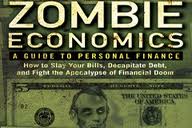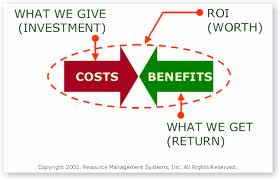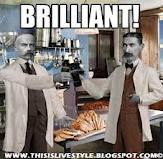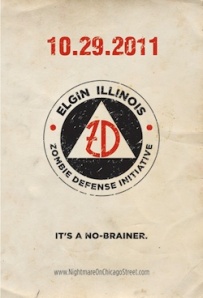 So, last week was an amazing week for my blog. It appears that I struck upon a topic of interest for the non-profit community when I focused on special events and how some agencies make poor decisions around return on investment (ROI) decisions and volunteer utilization. While I promised myself that I would end that discussion thread about zombies, I decided this morning over coffee to continue down “the yellow brick road” a little further by changing metaphors. It is Halloween season after all. LOL
So, last week was an amazing week for my blog. It appears that I struck upon a topic of interest for the non-profit community when I focused on special events and how some agencies make poor decisions around return on investment (ROI) decisions and volunteer utilization. While I promised myself that I would end that discussion thread about zombies, I decided this morning over coffee to continue down “the yellow brick road” a little further by changing metaphors. It is Halloween season after all. LOL
Interestingly, approximately 97-percent of all the emails, comments and discussions last week were very supportive of the positions I staked out in the blog. However, in spite of the support I still periodically heard things like this:
- Erik, I totally agree with you that non-profit leaders too often invest money and energy into special events that provide a poor ROI. We really need to do a better job. However, my agency runs this one event that has a bad ROI but we just LOVE IT. We just need to give it a little more time and it will be one of this community’s signature events. What do you think?
- Erik, as a board member I am not an expert on non-profit operations and fundraising. I rely on our agency’s staff to make good decisions, and I do as I am told. I agree with everything you’ve written and would never run my business that way, but it just isn’t my call.
- Erik, we knew this event wasn’t a good idea for non-profits, but what were we supposed to do? Non-profit agencies pushed us to include them in our event plans.
Again . . . let me attach this disclaimer before saying anything else. 1) Not all special events are bad. 2) Some special events can have a decent ROI. 3) There are non-monetary objectives and benefits to planning and running a special event (e.g. awareness, prospect cultivation, volunteer engagement, etc). 4) I believe all non-profit organizations should include one or two well-oiled special events in their annual written resource development plan.
With that being said, I found this iconic song from the Wizard of Oz’s Scarecrow running through my head after each of the aforementioned comments. I am not sure how you feel, but here were a few of my reactions and conclusions:
- It is probably common for agency staff and board volunteers to “fall in love with” their own special event ideas. Finding perspective is not an easy thing to do with anything in life including evaluating events and resource development programs. With this in mind, I recommend that non-profits involve external people in their evaluation process. What is so wrong with recruiting local business people to volunteer for a critique meeting or evaluation session? Ask donors to participate. Heck . . . spend a few dollars and engage an external consultant to help.
- The mysterious world of “non-profit” business models probably seems a bit strange to board volunteers who live in the for-profit world, but fiduciary responsibility is the same on both sides of the fence. I have a few thoughts here: 1) board volunteers must be engaged and cannot abdicate oversight and evaluation to staff, 2) while there are differences between for-profit and non-profit corporations, you should stop and think hard about something your agency is doing if you find yourself thinking “huh, I would never do that back at my shop,” 3) we don’t need zombies serving on our boards . . . we need leaders, and 4) non-profit staff really need to do a better job supporting their board development committees throughout the prospect identification, evaluation, recruitment, and orientation processes or they will get what they deserve which is a board room full of “yes men (and women)” who serve in an echo chamber.
- Eeeeeek! You knew it was a “bad idea,” but you did it because they asked for it? This comment almost sent me into orbit. So, answer me this question please: would you hand an addict a crack pipe? Or even better . . . do you give your kids everything they ask for? Now, please don’t get upset. I don’t mean to say that non-profits are addicts or children, but I make these analogies to get your attention. The answer is OF COURSE NOT! If you love someone (or in this case that someone is a non-profit agency and its mission), then you don’t enable them to do harm to themselves.
I believe that donors are more than just ATMs. I believe donors are leaders and accountability agents for the non-profit organizations they support. However, non-profit CEOs and fundraising professionals need to play a major role in empowering donors and volunteers. In the movie, “the wizard” bestows a diploma upon the Scarecrow as proof that he has a brain. What can agency staff bestow upon volunteers, donors and board members that will help them suddenly realize that their thoughts and wisdom are so desperately needed as part of the process?
Non-profit staff — Do you engage donors and external volunteers in the evaluation process? What about engaging them in the planning process? Do you have any examples of where you stopped doing something or changed it because of feedback from donors?
Donors — What stops you from sharing your thoughts and opinions about questionable things you see your favorite non-profits doing? Have you ever just stopped contributing to a charity as a result of a poor business decision that you saw a non-profit undertaking?
Board members — What can agency staff do to better empower you to speak-up and engage?
Please use the comment box below to share your thoughts and opinions because we can all learn from each other.
Here is to your health!
Erik Anderson
Founder & President, The Healthy Non-Profit LLC
www.thehealthynonprofit.com
erik@thehealthynonprofit.com
http://twitter.com/#!/eanderson847
http://www.facebook.com/eanderson847|
http://www.linkedin.com/in/erikanderson847


















